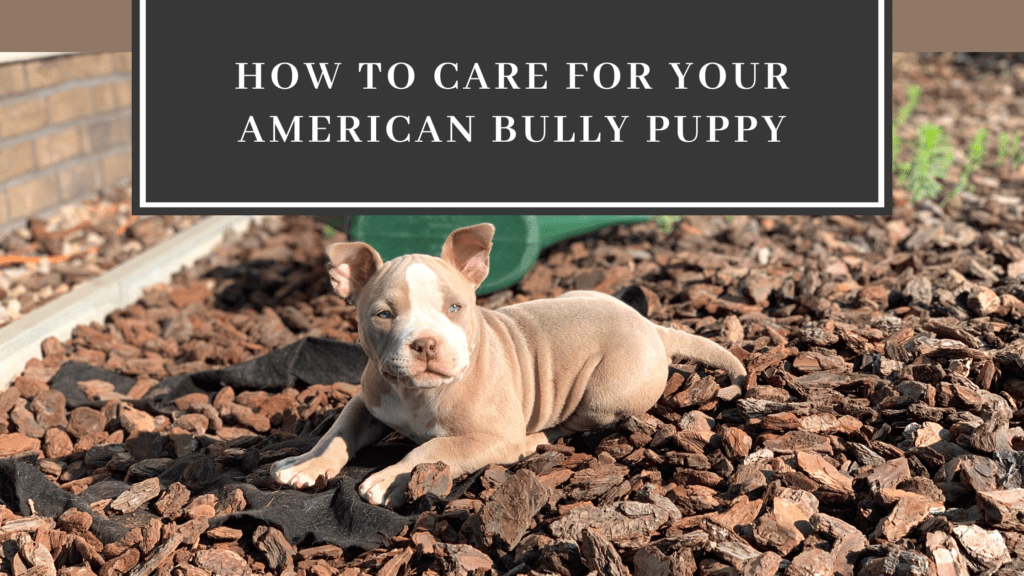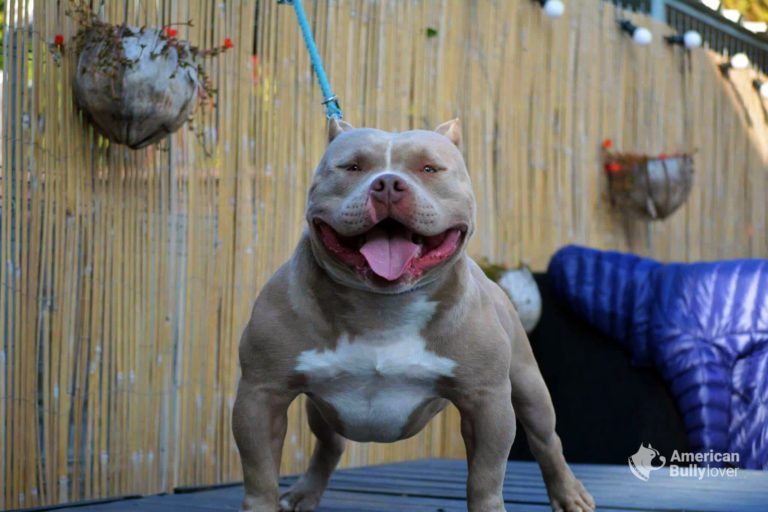Bringing home an American Bully puppy for the first time is an exciting and potentially daunting experience. Your primary goal should be to ensure your puppy’s safety, security, and mental well-being. Our guide to puppy care will provide you with some general rules to help your puppy get off to the best start in life and avoid potential problems down the road.
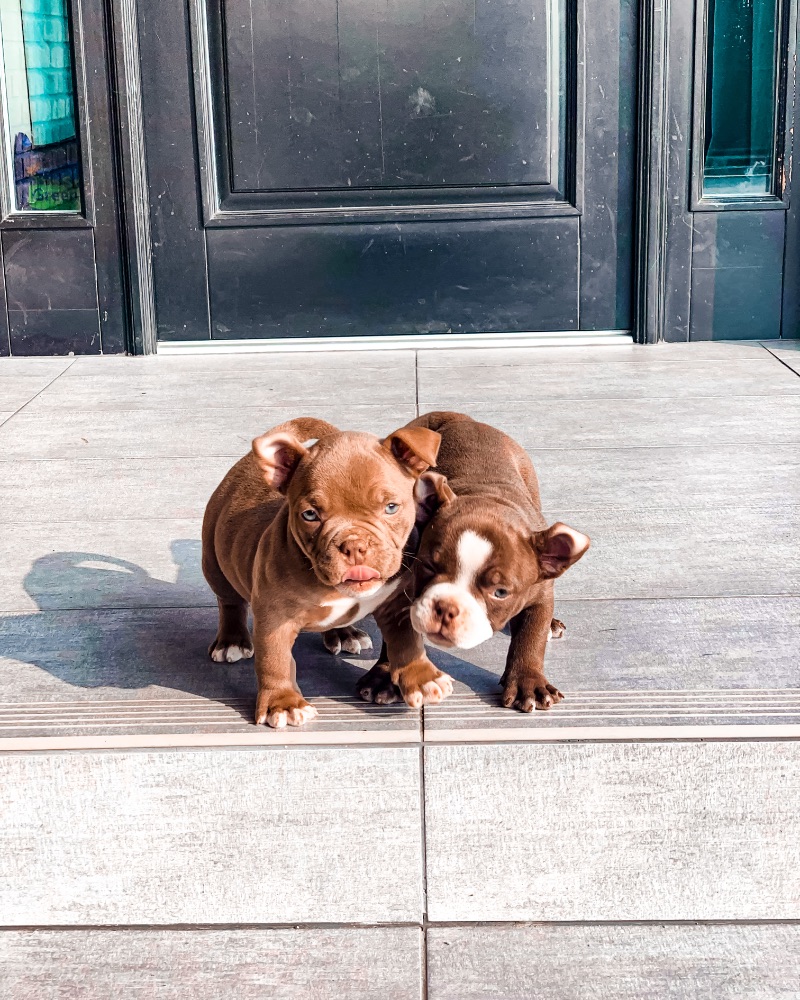


Before bringing your American Bully puppy home
1. Find a good veterinarian
It is highly recommended that you visit a veterinarian for a check-up within the first week, if not the first day, of bringing your puppy home. This will allow you to arrange for a veterinarian who is experienced with the American Bully breed, if possible. This visit will not only help ensure that your puppy is healthy, but it will also help you establish a good preventive health routine. During the first visit, be sure to discuss the vaccination plan for your puppy and options for controlling parasites.
It is also useful to know the location of the closest emergency facilities with a veterinarian on call after hours.
2. Prepare your home and family for your puppy’s arrival
Before your puppy arrives, take the time to review your property or apartment for safety. You may need to secure your fence to prevent your puppy from accidentally getting out and to keep intruders from getting in. Look for potential hazards in the environment that could injure your dog, such as small objects that your puppy could easily swallow, sharp objects that they could cut themselves on, or unstable objects that they could knock over. Be aware of poisonous plants, electrical cables, and other animals that could pose a threat to small dogs.
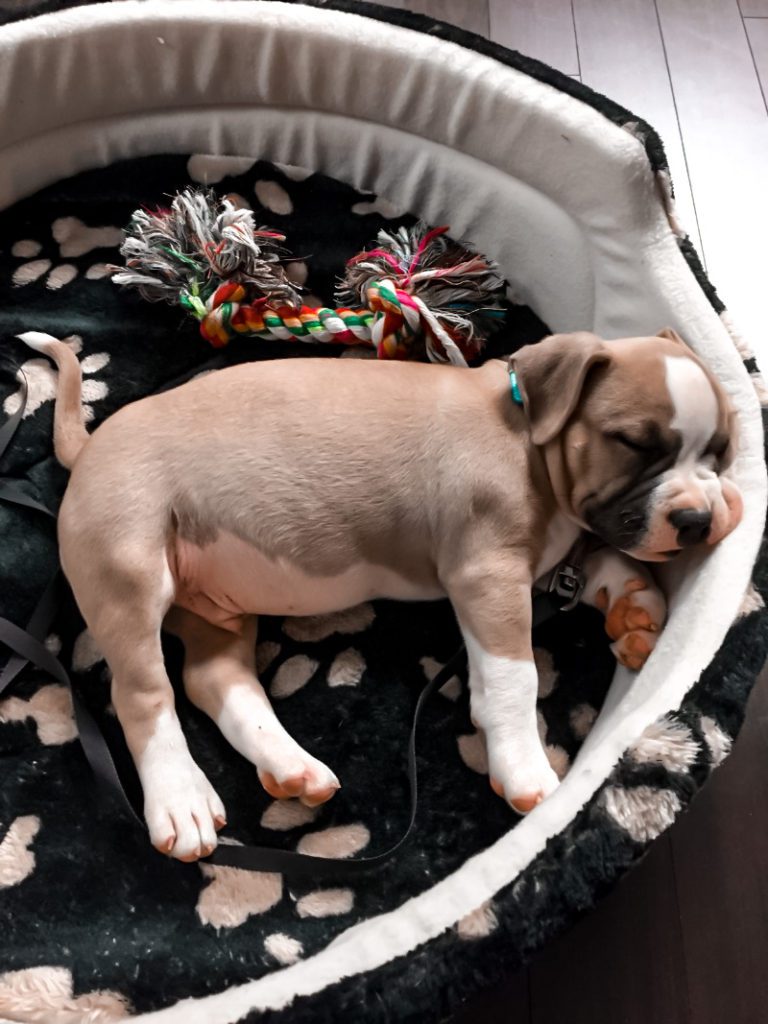
It is also important to discuss certain things with your family before your new family member arrives, such as:
- Responsibilities: Discuss within your family who will be responsible for various tasks.
- Daily routine: Determine a plan for your puppy’s daily routine, including their sleep and wake times, feeding schedule, exercise and playtime, and bathroom breaks.
- Location: Decide where your puppy’s bed, toys, and bowls will be located.
- Name and commands: Choose a name for your puppy and establish cues for commands.
- Rules: Discuss some general rules, such as which rooms your dog will be allowed to enter, whether they will be allowed to jump on the furniture or sleep in your bed, etc. These are important decisions to make before your puppy arrives.
3. Gather Essential Gear for Your American Bully Puppy
Once you have prepared your home and family for your new American Bully puppy, it’s time to gather the essential gear they will need. This should include:
- Dog food and treats: Start with the food your puppy is used to, and gradually switch to a different food with no corn or grains. You may want to consider the alternative BARF diet.
- Edible bones: Most raw bones that have not been cooked are safe for dogs to eat. Avoid cooked bones, as they can easily break and splinter. Raw chicken, turkey, lamb, or beef bones are soft enough for your puppy to chew, eat, and digest.
- Stainless steel bowls for food and water: These resist bacteria and are easy to clean.
- Collar with ID tag: Choose a flat buckle collar for safety, and attach an ID tag with your contact information in case your puppy gets lost.
- Leash or harness: Try both to see which works best for you and your puppy.
- First aid kit: As a responsible pet owner, it’s important to be prepared for potential injuries. A first aid kit can help save your puppy’s life in an emergency.
- Crate, blanket, and toys: Your puppy will need a safe, comfortable place to rest and sleep. Make their crate cozy with a bed and toys, and consider using a blanket from their first home for the first few days to help them adjust to their new environment. Avoid toys with endocrine-disrupting BPAs and toxic lead, and opt for eco-friendly options like bamboo or hemp toys. Chewber makes durable, natural rubber toys in the USA.
Welcome an American Bully puppy into your home

Bringing a puppy home is an exciting event for the whole family. This puppy will be in a new environment with new sounds, smells, and a brand new family to meet.
To introduce your new puppy to its new home, place it on a leash and allow it to explore its surroundings under your control. This will allow you to observe how your puppy reacts to different objects in the house and whether it is curious or cautious.
Crate training is a useful tool for establishing good sleep habits and bathroom routines for your puppy. Although it may seem isolating at first, a crate can provide your puppy with a safe and comfortable space to call its own. It can also prevent them from getting into trouble while you’re sleeping.
Your primary goal when bringing a puppy home should be to ensure its safety, security, and mental well-being. Being too lenient with your dog will not damage it permanently, but being too harsh, such as dominating or causing fear, can injure it for a lifetime. Establish a loving and trusting relationship with your puppy by being kind and gentle.
The nutrition and feeding schedule of an American Bully puppy
Proper nutrition is essential for maintaining the health of your American Bully puppy. It is best to consult with a veterinarian or the breeder you purchased your puppy from to determine the best brand of food to use. Choose a brand and stick with it, as switching brands frequently can cause gastrointestinal issues.
Puppies have higher nutritional needs than adult dogs due to their rapid growth. Feed your American Bully puppy multiple times a day according to its age:
- 8-12 weeks: 4 meals per day
- 3-6 months: 3 meals per day
- 6-12 months: 2 meals per day
For American Bullies under a year is recommended a high protein, high-fat food. The first 3 listed ingredients should be a form of meat, not corn or grains.
There are a lot of premium pet foods on the market that will have these ingredients. You can look for a statement from the Association of American Feed Control Officials (AAFCO) on the packaging (if you are from the USA) to ensure that the food you choose will meet your puppy’s nutritional requirements. When switching to a new brand, always look for changes in your puppy’s skin, and itching around the eyes and feet if your dog has a food allergy or reacts to certain ingredients in their food.
Raw feeding may be an excellent choice as well. When you bring home a new puppy that was not raised on raw, it can be a bit trickier to get him started. This article contains 9 Tips For Starting Your Puppy On A Raw Diet.
According to Bully King magazine blog it is best to feed an American Bully puppy as much as it can eat and to keep some fat on your Bully puppy. This will aid in proper growth. As your Bully gets older, their feeding patterns will change. After a year to a year ½, you should feed your dog enough to maintain a full look, but not overweight. Their metabolism will change on its own, and you will see the puppy fat change into muscle.
Many American Bully owners think they need to achieve a bulky look for any price. They buy expensive dog supplements, which allegedly ensure a muscular body. For sure, you may feed your dog to maintain a full look, but if your dog doesn’t have the genetic makeup to have a “bullier” build, then all the supplements and training in the world aren’t going to add on the muscle mass you desire.
Health issues, vaccinations, and worming for American Bully dogs
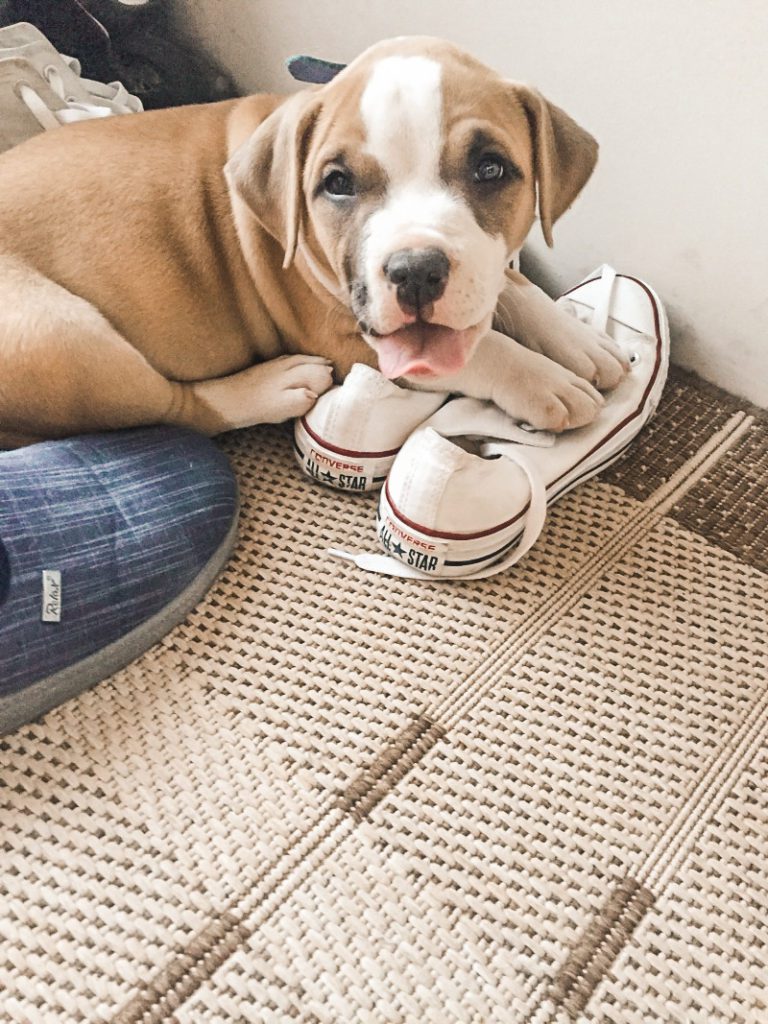
As the American Bully is a relatively new breed, no specific health studies have been conducted on the breed to date. However, we can predict potential health issues by examining the older breeds that make up its genetic makeup.
One potential health issue in American Bully dogs is demodicosis, also known as Demodex mange or Demodectic mange. This condition is caused by a species of mite that is present on the skin of almost all dogs. The mite is transferred from the mother dog to her puppies while nursing. In most cases, the mite causes no problems for dogs, but in some cases, it triggers an autoimmune reaction that causes hair loss, also known as mange. Demodicosis can affect a small patch of skin or the entire dog, depending on its severity. There are various treatment options available, although some cases do not require treatment.
Other health issues that commonly occur in American Pit Bull Terriers, and may also affect American Bully dogs, including hip dysplasia, elbow dysplasia, and visual problems. It is highly recommended that owners have their pets tested by both the Orthopedic Foundation for Animals (OFA) and the Canine Eye Registration Foundation (CERF). These organizations perform genetic and other tests to identify potential health defects before they manifest. This is especially useful for detecting conditions that do not show up until the dog has reached an advanced age. It is especially important for anyone considering breeding their American Bully to have them tested to prevent the spread of potential genetic conditions to their offspring.
Dental disease is the most common chronic problem in pets, affecting 80% of all dogs by age two. American Bully dogs, like Staffordshire Bull Terriers, are more likely to have problems with their teeth. Dental disease starts with tartar build-up on the teeth and progresses to infection of the gums and roots of the teeth. If left untreated, dental disease can lead to tooth loss and put your dog at risk of damage to their kidneys, liver, heart, and joints.
American Bully puppies are typically vaccinated at eight and ten weeks of age (although they can be vaccinated as early as four to six weeks), with the second dose given two to four weeks later. Consult with your veterinarian to determine the best vaccination schedule for your puppy. As your American Bully grows into an adult dog, it is essential to keep their vaccinations up to date and visit your veterinarian regularly. When your American Bully reaches 6 months of age, have your veterinarian administer a 3-year rabies vaccination. Rabies vaccinations should be repeated every three years. Have your veterinarian perform a complete health check on your American Bully once a year. Check out this blog post to get some useful information about vaccinations for first-time dog owners.
Dogs can be infected with various types of worms, including hookworms, roundworms, tapeworms, whipworms, and heartworms. Some sources indicate that most dogs, even healthy ones, host a low level of worms nearly all the time. To protect your American Bully and your home, wipe down your dog’s paws when you come in from walks to reduce their exposure to larvae. Always wash your hands thoroughly after petting your American Bully to prevent transmitting worms to yourself. It is recommended to start your American Bully puppy on a heartworm preventative at 4 months of age. Some preventatives also kill other types of worms. You should repeat the worming process 14 days after the initial treatment. Tapeworms require a 3-day treatment.
Getting the most out of the first weeks with your American Bully puppy

After introducing your American Bully puppy to his new family and environment, you should teach him where his water bowl is located so he can access fresh water any time he needs it. The puppy should also know from the first day where his bed is and where to go to the bathroom. Whether you choose to use a crate or a fluffy bed for your puppy, it is crucial that he feels safe there and can have undisturbed rest time. After these essential things, you should begin to establish a loving relationship with your new puppy, which can reduce potential anxiety. He will quickly learn that you are his people, whom he can trust and love unconditionally. By providing your American Bully puppy with gentle, loving care while also establishing rules and boundaries, you set him up for success.
It takes about two months of consistent use for your dog to become very familiar with his name. You should also start teaching your American Bully puppy the house rules, and establish his bathroom routine, feeding routine, and daily routine. You will achieve the best results with your puppy when sticking to a carefully designed schedule, which can be modified according to your and your dog’s changing needs. You can begin teaching your American Bully puppy to wear a collar in a compassionate way, so he has a positive association with it. Gently scratch his neck to get him used to you touching it, then put his collar on and immediately take him on a walk or play with a ball to distract him from the collar. When introducing a leash, use it at meal times to create a positive association.
Just like obedience training, proper socialization during an American Bully’s puppyhood helps avoid behavioral problems down the road. At approximately 2 to 4 months of age, most puppies begin to accept other animals, people, places, and experiences. It’s important to set the tone from the start so your puppy will understand, that he may not bully or overrun your child or the cat. The best way to achieve it is to teach your puppy how to interact calmly with other animals and also other family members. You should remember to teach the children as well, how to act respectfully toward the dog.
For an American Bully puppy, it is very wise to introduce other healthy animals from an early age, as they tend to have prey instinct. Begin by giving him the cat blanket to investigate, this may reduce the excitement of meeting the live cat. His natural instincts can be kept in check, however, with firm and consistent enforcement of house rules. You may use the word “gentle” in a soft but firm intonation.
Meeting new people, animals and places can be exciting for your puppy but sometimes also scary. Introduce them to these new things in a way that feels safe and gives them the confidence to handle the situation. It may be the first visit to the vet or the first nail trimming, your puppy may be anxious with these new experiences. A little extra time, in the beginning, will help your puppy for a lifetime to be a healthy and balanced dog.
